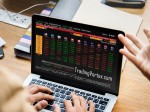Table Of Contents:
- What is Algorithmic Trading?
- How Algorithmic Trading Works?
- Benefits of Algorithmic Trading:
- Popular Algorithmic Trading Strategies:
- Tools and Technologies for Algorithmic Trading:
- Risks and Challenges in Algorithmic Trading:
- Getting Started with Algorithmic Trading:
- Case Studies and Real-World Examples:
- The Future of Algorithmic Trading:
- Embracing the Future – Concluding Insights on Algorithmic Trading:
What is Algorithmic Trading?
Definition and Overview:
Alright, let’s dive into the fascinating world of algorithmic trading. You’ve probably heard the term thrown around in trading circles, maybe even at that last conference where everyone seemed just a bit too excited about “quants.” At its core, algorithmic trading, often simply called “algo trading,” is the use of computer algorithms to automate trading decisions. Instead of manually placing trades, algorithms do the heavy lifting for you. Imagine having a super-smart assistant who never sleeps, doesn’t get emotional, and can execute trades faster than you can say “buy low, sell high.”
These algorithms follow a set of predefined rules and strategies. They can range from simple conditions like “buy if stock price drops by 5%” to more complex ones involving multiple data points and predictive analytics. Essentially, algorithmic trading is about leveraging the power of computers to enhance trading efficiency and accuracy.
History and Evolution:
Now, how did we get here? The journey of algorithmic trading is as intriguing as the concept itself. It all started in the 1970s with the advent of electronic trading platforms. Before that, trading was a noisy, chaotic scene on the floor of stock exchanges – think of those classic movies where brokers are shouting and waving papers. Electronic platforms began to change all that, making it possible to execute trades faster and more efficiently.
The real game-changer came in the 1980s and 1990s with advancements in computer technology and the introduction of direct market access (DMA). Traders could now interact directly with order books, bypassing traditional broker-dealers. Fast forward to the 2000s, and high-frequency trading (HFT) emerged, leveraging sophisticated algorithms and ultra-fast data feeds to execute a large number of trades in fractions of a second.
Today, algorithmic trading is mainstream, used by major financial institutions, hedge funds, and even individual traders like you and me. It’s continuously evolving, integrating artificial intelligence and machine learning to refine strategies and predict market movements more accurately.
Types of Algorithmic Trading Strategies:
Let’s get into the meat of it – what kinds of strategies can these algorithms deploy? There’s a whole smorgasbord of options here, and choosing the right one depends on your trading style, goals, and risk tolerance.
- Market Making: This strategy involves simultaneously placing buy and sell orders to profit from the bid-ask spread. Think of it as being the middleman, facilitating trades and making small profits on each transaction.
- Trend Following: Ever heard the phrase, “the trend is your friend”? That’s the mantra here. These algorithms identify and ride market trends, whether upward or downward. They’re based on technical indicators like moving averages and price momentum.
- Arbitrage: This is the practice of taking advantage of price differences between markets. For example, buying a stock on one exchange where it’s cheaper and selling it on another where it’s more expensive. Arbitrage algorithms are quick to spot and act on these discrepancies.
- Mean Reversion: This strategy is based on the idea that prices will revert to their mean over time. If a stock’s price deviates significantly from its historical average, the algorithm bets on it returning to that average.
- Sentiment Analysis: These algorithms gauge market sentiment by analyzing news, social media, and other sources of public opinion. If the sentiment is positive, the algorithm might buy; if negative, it might sell.
So, there you have it – a primer on what algorithmic trading is, where it came from, and the strategies it employs. It’s a field that’s constantly evolving, blending traditional trading wisdom with cutting-edge technology. And trust me, whether you’re a newbie or a seasoned trader, understanding and leveraging algorithmic trading can be a game-changer in your trading journey.
How Algorithmic Trading Works?
The Role of Algorithms in Trading:
Let’s kick things off with the basics – what exactly do these magical algorithms do in the trading world? At their core, trading algorithms are like supercharged recipe cards for making profitable trades. They tell your computer exactly when to buy, sell, or hold a position based on a set of rules you’ve defined. Picture it like having a super-nerdy friend who’s also incredibly precise and never sleeps; they’re always on the lookout for the perfect trading opportunities according to your exact preferences.
Algorithms can be straightforward, focusing on simple conditions like price thresholds, or they can be incredibly complex, using intricate mathematical models and machine learning to predict market movements. The beauty of these algorithms is their ability to analyze vast amounts of data in real time and execute trades at lightning speed, way faster than any human could manage.
Key Components of Algorithmic Trading Systems:
Alright, so now that we know what algorithms do, let’s break down the main components of an algorithmic trading system. Think of it like building a high-performance car; you need the right engine, fuel, and control systems.
Trading Algorithms:
This is the heart of the operation. Your trading algorithm is a set of instructions written in a programming language (Python, R, C++, etc.). These instructions define how the system will interpret data and make trading decisions. You can create algorithms for various strategies like market making, trend following, or arbitrage.
Data Feeds and Market Data:
Next up, we have the fuel: data. Your algorithm needs access to high-quality, real-time market data to make informed decisions. This includes price quotes, trade volumes, historical data, and news feeds. Without accurate data, even the best algorithm can’t function properly. It’s like trying to drive that high-performance car without gasoline or a map.
Execution Platforms:
Finally, we need a way to execute the trades. This is where execution platforms come in. These platforms connect directly to the stock exchange or trading venue, allowing your algorithm to place buy and sell orders automatically. It’s crucial that these platforms are reliable and fast because in trading, milliseconds can make a huge difference.
Steps in Algorithmic Trading:
Building and running an algorithmic trading strategy is a bit like baking a cake – you need to follow specific steps to get the perfect result. Here’s a breakdown:
Strategy Formulation:
First, you need a solid trading strategy. This involves deciding what you want your algorithm to achieve.
- Are you looking to capitalize on short-term price movements or long-term trends?
- Will you focus on a specific market or diversify across several?
This step is crucial and requires a deep understanding of market behavior and trading principles.
Backtesting:
Once you have your strategy, it’s time to test it against historical data. This process, known as backtesting, helps you see how your algorithm would have performed in the past. It’s like taking your recipe and testing it with real ingredients before serving it at a dinner party. You’ll need to tweak and refine your algorithm based on these results to improve its performance.
Execution:
With a backtested and refined algorithm, you’re ready to go live. Execution is the phase where your algorithm starts trading in the real market. This step requires robust infrastructure to ensure your trades are executed quickly and accurately. It’s where the rubber meets the road, and all your preparation pays off.
Performance Monitoring:
Even after going live, your job isn’t over. Continuous performance monitoring is essential to ensure your algorithm is working as expected. This involves tracking key metrics like profitability, drawdowns, and execution quality. Think of it as regularly checking the engine and tire pressure on your high-performance car to keep it running smoothly.
Algorithmic trading can seem intimidating at first, but breaking it down into these components and steps makes it much more approachable. It's like assembling a complex yet rewarding puzzle where each piece has its place. And trust me, once you see your algorithm in action, making trades while you sip your morning coffee, you’ll realize just how powerful and exciting this world can be. Happy trading!
Benefits of Algorithmic Trading:
Alright, folks, let’s get to the fun part – why should you even bother with algorithmic trading? What makes it so special that everyone from big-shot hedge funds to individual traders is jumping on the algo train? Let me walk you through the standout benefits of algorithmic trading, and trust me, you’ll see why it’s worth considering.
Speed and Efficiency:
First up, speed and efficiency. Imagine having a trading assistant who can analyze the market, crunch the numbers, and execute trades all in the blink of an eye. That’s what algorithmic trading brings to the table. These algorithms can process vast amounts of data and make decisions in microseconds.
I remember the old days when I used to manually enter trades, constantly refreshing my screen for the latest prices. It was like playing whack-a-mole, except with my financial future on the line. With algorithms, those days are long gone. The speed at which trades are executed means you can capitalize on fleeting market opportunities that humans would simply miss.
Reduced Transaction Costs:
Let’s talk money – specifically, how much you’re spending to make trades? Traditional trading can rack up significant costs, especially with frequent buying and selling. However, algorithmic trading can help reduce these transaction costs.
When you automate trading, you avoid the slippage that often occurs with manual trading. Algorithms execute trades at the best possible prices and can break down large orders into smaller chunks to minimize market impact. It’s like having a savvy shopper who always finds the best deals and avoids those sneaky hidden fees.
Improved Accuracy:
Accuracy in trading is like accuracy in archery – the closer you get to the bullseye, the better. Algorithms, unlike humans, aren’t prone to errors caused by fatigue or distraction. They follow predefined rules to the letter, ensuring that every trade is executed precisely as intended.
A while back, I remember manually calculating some complex trade conditions late at night. After hours of work, I made a tiny error that cost me a significant amount of money. That’s when I truly appreciated the precision of algorithms. They don’t get tired, they don’t get distracted, and they don’t make those small but costly mistakes.
Minimized Emotional Bias:
We’ve all been there – letting emotions drive our trading decisions. Fear, greed, and even overconfidence can lead to suboptimal trades. One of the biggest advantages of algorithmic trading is that it completely removes emotional bias from the equation.
Algorithms don’t panic during market dips or get overly excited during rallies. They stick to the plan, executing trades based on logic and data rather than gut feelings. It’s like having a poker-faced trader who always plays the odds, never the emotions.
Enhanced Diversification:
Finally, let’s talk about diversification. Diversifying your portfolio is essential for managing risk, but doing it manually can be incredibly time-consuming and complex. Algorithmic trading makes diversification much more accessible and efficient.
Algorithms can simultaneously monitor and trade across multiple markets and asset classes, something that would be virtually impossible for a human trader to manage effectively. They can swiftly rebalance portfolios to ensure optimal asset allocation, spreading risk and maximizing potential returns.
In essence, algorithmic trading offers a suite of benefits that can significantly enhance your trading performance. From lightning-fast execution and reduced costs to improved accuracy, emotional neutrality, and enhanced diversification, it’s no wonder that more and more traders are embracing this technology.
So, whether you’re just dipping your toes into the world of trading or you’re a seasoned pro looking to up your game, algorithmic trading can be a powerful ally in your trading arsenal. Happy trading, and may your algorithms always be in your favor!
Popular Algorithmic Trading Strategies:
Alright, let’s get to the juicy part – what strategies can you deploy with your shiny new trading algorithms? There’s a whole buffet of strategies out there, each with its unique flavor and approach. Think of it like picking the right tool for the job. Whether you’re into the high-speed game or prefer a more laid-back approach, there’s something here for everyone. Let’s dive into some of the most popular algorithmic trading strategies.
Market Making:
First up, we have market making. Picture yourself as a shopkeeper in a bustling market, always ready to buy and sell goods at your stall. Market making algorithms do just that – they continuously place buy and sell orders to capture the bid-ask spread.
By providing liquidity to the market, these algorithms profit from the tiny differences between the buying and selling prices. It’s a bit like earning a small commission for facilitating trades. A friend of mine, who’s been in the game for years, swears by market making. He compares it to fishing; you set your lines (orders) and patiently wait for the fish (trades) to bite.
Trend Following:
Next, let’s talk about trend following. If you’ve ever heard the saying, “the trend is your friend,” this strategy embodies that philosophy. Trend following algorithms look for patterns and trends in the market, hopping on board and riding them as long as they last.
These algorithms use technical indicators like moving averages and momentum indicators to identify trends. When the market is trending upwards, they buy; when it’s trending downwards, they sell. It’s like surfing – catch the wave early, and ride it until it starts to break. I once tried my hand at trend following manually, and let me tell you, having an algorithm to do it for you is a game-changer. It’s much more consistent and doesn’t miss a beat.
Arbitrage:
Arbitrage is the trading equivalent of a treasure hunt. These algorithms exploit price discrepancies between different markets or instruments. For example, if a stock is priced differently on two exchanges, an arbitrage algorithm will buy on the cheaper exchange and sell on the more expensive one, pocketing the difference.
This strategy requires lightning-fast execution and access to multiple markets, but when done right, it’s almost like printing money. I remember a colleague who used to run manual arbitrage trades between cryptocurrency exchanges. He’d stay up all night tracking prices – his excitement was palpable every time he found a profitable gap. Nowadays, algorithms handle all that hustle, and he gets a lot more sleep.
Mean Reversion:
Now, onto mean reversion. This strategy is based on the idea that prices will eventually revert to their historical average. If a stock’s price drifts too far from its average, a mean reversion algorithm will bet on it returning to that average.
It’s like betting that a rubber band, when stretched, will snap back to its original shape. These algorithms look for overbought or oversold conditions and trade accordingly. Back in the day, I used to eyeball charts looking for these opportunities, but it’s tough to stay objective. Algorithms, on the other hand, are relentless and precise, making them perfect for this strategy.
Sentiment Analysis:
Last but not least, let’s delve into sentiment analysis. In today’s digital age, market sentiment is often driven by news, social media, and other online chatter. Sentiment analysis algorithms scour these sources to gauge the mood of the market and make trades based on that information.
It’s like having a finger on the pulse of the trading world. These algorithms use natural language processing and machine learning to interpret and quantify sentiment. I have a friend who’s a news junkie, always reading the latest financial headlines to get a trading edge. He recently started using sentiment analysis algorithms and was amazed at how quickly they can process and act on vast amounts of information – way faster than any human could.
So there you have it, a rundown of some popular algorithmic trading strategies. Whether you’re providing liquidity, riding trends, hunting for arbitrage opportunities, betting on mean reversion, or analyzing market sentiment, there’s an algo strategy that can help you achieve your trading goals. Each of these strategies brings its own set of advantages, and the best part? Your algorithms handle the heavy lifting while you focus on the bigger picture. Happy trading, and may your strategies always be profitable!
Tools and Technologies for Algorithmic Trading:
Alright, let’s roll up our sleeves and dig into the toolbox that makes algorithmic trading possible. It’s like setting up a state-of-the-art kitchen – each tool and gadget plays a crucial role in whipping up that perfect trading strategy. Here’s a breakdown of the essential tools and technologies you’ll need.
Trading Platforms:
First things first, you need a solid trading platform. Think of it as the foundation of your trading operations. A good platform provides the necessary infrastructure to develop, test, and execute your trading algorithms. It’s like the kitchen where all the cooking happens.
MetaTrader and TradeStation are popular choices among traders. These platforms offer robust features, including real-time market data, comprehensive charting tools, and backtesting capabilities. I started my journey with MetaTrader, and let me tell you, having a reliable platform made all the difference. It’s like having a well-organized kitchen where everything is within reach.
Programming Languages and Software:
Now, let’s talk about the languages of the trade. These are the coding tools you’ll use to write your trading algorithms. Think of them as the recipes that guide your cooking.
- Python: Python is the darling of the trading world. It’s user-friendly, versatile, and has a rich ecosystem of libraries for data analysis, backtesting, and machine learning. If you’re new to coding, Python is a great place to start. I remember my first Python script – it felt like magic when I saw my algorithm executing trades flawlessly. Libraries like Pandas for data manipulation and Backtrader for backtesting make Python a powerhouse in algo trading.
- R: R is another heavyweight, especially popular among statisticians and data scientists. It’s excellent for data analysis and visualization. If you’re diving deep into statistical models or need top-notch data visualization, R is your go-to. A friend of mine, a data science whiz, swears by R for its comprehensive statistical packages. Libraries like quantmod and TTR are particularly useful for financial analysis.
- MATLAB: For those who crave precision and high-level mathematical capabilities, MATLAB is the tool of choice. It’s powerful for numerical computing and has a robust set of toolboxes for financial analysis. I used MATLAB extensively during my early trading days for its seamless handling of complex mathematical models. It’s like having a high-end mixer that can handle any recipe you throw at it.
Data Providers and APIs:
Data is the lifeblood of algorithmic trading. Without high-quality data, your algorithms are like chefs without ingredients. You need reliable data providers and APIs to feed your algorithms real-time and historical market data.
Alpha Vantage, Quandl, and IEX Cloud are popular choices. These services provide extensive data feeds that you can integrate with your trading algorithms. I recall the early days of manually pulling data – what a hassle! Nowadays, APIs make it effortless to stream data directly into your algorithms, ensuring they have the freshest information to work with.
Machine Learning and AI in Trading:
Last but definitely not least, let’s talk about the cutting-edge: machine learning and AI. These technologies are transforming the trading landscape, offering unprecedented insights and predictive power.
Machine learning algorithms can analyze vast amounts of data, identify patterns, and make predictions with remarkable accuracy. Libraries like scikit-learn and TensorFlow in Python are widely used for building and deploying machine learning models.
I remember a turning point in my trading career when I integrated a machine learning model to predict market movements. It was like adding a secret ingredient to my trading recipe that elevated the entire dish. AI models can adapt and learn from new data, continually improving their performance.
So there you have it – a comprehensive overview of the essential tools and technologies for algorithmic trading. From robust trading platforms and powerful programming languages to reliable data providers and cutting-edge machine learning, each tool plays a vital role in crafting your trading strategies. It’s a dynamic and ever-evolving toolkit, but with the right setup, you’ll be well-equipped to navigate the exciting world of algo trading. Happy trading, and may your toolbox always be stocked with the best!
Risks and Challenges in Algorithmic Trading:
Alright, now that we’ve covered the glitz and glam of algorithmic trading, it’s time to get real about the risks and challenges. Every silver lining has a cloud, right? Algorithmic trading can be incredibly rewarding, but it’s not without its pitfalls. Let’s take a candid look at some of the major risks and challenges you might face. Trust me, being aware of these can save you from some serious headaches down the road.
Market Risks:
First off, market risks. These are the same risks you face with any form of trading, but with algorithms, they can be magnified. Algorithms react to market conditions based on pre-set rules, but markets can be unpredictable and chaotic. Unexpected news, geopolitical events, or even other algorithms behaving badly can throw a wrench in your plans.
I remember a time when an algorithm I was using completely misread a sudden market shift. It was like watching a perfectly good soufflé collapse because of an unexpected gust of wind. To mitigate market risks, always ensure your algorithms are robust and flexible enough to handle various market scenarios. Diversification and constant monitoring can also help cushion the blow when the market goes haywire.
Technological Risks:
Next up, technological risks. These are the gremlins in the machine that can cause all sorts of trouble. From software bugs and hardware failures to latency issues and connectivity problems, technology can sometimes be your worst enemy.
I once had an algorithm that performed flawlessly in backtesting, but when it went live, a tiny bug caused it to place trades at the wrong times. It was a nightmare. To avoid such mishaps, thoroughly test your algorithms in simulated environments and have contingency plans in place. Regular maintenance and updates to your hardware and software infrastructure are crucial to keep everything running smoothly.
Regulatory and Compliance Issues:
Let’s not forget the regulatory and compliance maze. The world of trading is heavily regulated, and for good reason. Algorithms must comply with various regulations to ensure fair and transparent markets. Regulatory bodies are always watching, and any slip-ups can lead to hefty fines or worse.
Navigating this landscape can be tricky. I’ve had my fair share of close calls where a seemingly harmless algorithmic strategy bumped into regulatory constraints. Staying informed about the latest regulations and ensuring your algorithms are compliant is non-negotiable. It’s like driving – understanding and obeying traffic laws is crucial to avoid accidents and fines.
Ethical Considerations:
Finally, there are ethical considerations. Algorithmic trading can sometimes lead to unintended consequences, such as exacerbating market volatility or creating unfair advantages. Flash crashes, where the market plummets in seconds only to recover just as quickly, are often linked to algorithmic trading gone awry.
I remember the 2010 Flash Crash like it was yesterday. It was a stark reminder of the potential impact algorithms can have on the market. As traders, we have a responsibility to use these powerful tools ethically. This means designing algorithms that don’t manipulate the market or exploit loopholes, and being mindful of their broader impact.
Algorithmic trading is a powerful tool, but it comes with its own set of risks and challenges. Market volatility, technological failures, regulatory hurdles, and ethical dilemmas are all part of the landscape. By being aware of these risks and preparing for them, you can navigate the world of algorithmic trading more safely and effectively.
Remember, trading is as much about managing risks as it is about seizing opportunities. Stay vigilant, keep learning, and always have a backup plan. Happy trading, and may your algorithms steer clear of the pitfalls!
Getting Started with Algorithmic Trading:
So, you’re ready to dip your toes into the exciting world of algorithmic trading? Fantastic! But where do you start? Let’s break it down step-by-step, keeping things casual and approachable. I remember my own journey into algo trading – it was a mix of excitement, confusion, and a whole lot of learning. Let’s make your path a bit smoother.
Building Your First Algorithm:
The steps to follow to build your first algorithm:
- Understanding the Basics: Before diving into code, understand the basic concepts. Learn about different asset classes, trading strategies, and risk management. A solid foundation is crucial. I remember feeling overwhelmed at first, but breaking things down into bite-sized pieces really helped.
- Selecting a Strategy: Choose a simple strategy to start with, like moving average crossovers or mean reversion. Don’t try to build the next high-frequency trading system right off the bat. Start small and build up. My first algorithm was a simple moving average crossover strategy, and while it wasn’t perfect, it taught me a lot about the mechanics of algorithmic trading.
- Coding and Backtesting: Start coding your algorithm using a language like Python. Use libraries like Pandas for data manipulation and Backtrader for backtesting. Backtesting is essential – it’s like practicing a recipe before serving it to guests. When I ran my first backtest, it was eye-opening to see how the algorithm performed over historical data.
Choosing a Brokerage:
Now, you need a brokerage that supports algorithmic trading. Not all brokerages are created equal, so choose one that offers the tools and data you need.
- Features to Look For: Look for brokerages that provide API access, real-time data feeds, and robust trading platforms. When I chose my first brokerage, I made sure they had a good API and solid customer support – trust me, you’ll need it.
- Paper Trading: Many brokerages offer paper trading accounts where you can test your algorithms in a real market environment without risking actual money. It’s like a dress rehearsal before the big performance.
Continuous Learning and Improvement:
Algorithmic trading is a journey, not a destination. Continuous learning and improvement are key to staying ahead.
- Stay Updated: The trading world is constantly evolving. Follow financial news, subscribe to trading journals, and keep an eye on new research and technologies. I have a daily routine of scanning through financial news and catching up on the latest in algorithmic trading research.
- Iterate and Improve: Always be prepared to iterate and improve your algorithms. Backtest new ideas, tweak your strategies, and never stop experimenting. I’ve lost count of how many times I’ve refined my algorithms based on new insights or market changes.
- Networking: Attend conferences, webinars, and meetups. Networking with other traders and professionals can provide new perspectives and ideas. Some of my best strategies came from casual conversations at trading meetups.
Getting started with algorithmic trading might seem daunting, but with the right resources and a step-by-step approach, it becomes much more manageable. Educate yourself, start small, choose the right tools, and always be ready to learn and adapt. Remember, every expert was once a beginner. Happy trading, and may your algorithms always be in the green!
Case Studies and Real-World Examples:
Let’s dive into some real-world stories from the world of algorithmic trading. These case studies and examples will give you a flavor of both the triumphs and pitfalls in this fascinating field. It’s like getting a peek behind the curtain at how the magic happens – or sometimes doesn’t.
Successful Algorithmic Trading Firms:
When it comes to algorithmic trading success, a few firms stand out as legends. These companies have leveraged cutting-edge technology, brilliant minds, and robust strategies to dominate the trading landscape.
Renaissance Technologies:
You can’t talk about successful algorithmic trading without mentioning Renaissance Technologies. Founded by Jim Simons, this firm is a powerhouse in the world of quantitative trading. Their Medallion Fund is famous for its stellar returns, often described as too good to be true. The secret sauce? A team of scientists and mathematicians developing highly sophisticated algorithms. Renaissance’s success story is a testament to the power of data-driven trading strategies.
Two Sigma:
Another heavyweight is Two Sigma, a firm that combines data science, technology, and financial expertise to manage billions in assets. Two Sigma’s approach revolves around finding patterns in vast amounts of data. They’ve built a reputation for using machine learning and artificial intelligence to make trading decisions. Their success shows how integrating advanced technology with trading can yield impressive results.
Individual Trader Success Stories:
It’s not just the big firms that find success with algorithmic trading. Individual traders can also hit it big. Let’s look at a couple of inspiring stories.
The Programmer Turned Trader:
I have a friend who started as a software developer but had a passion for the markets. He decided to merge his coding skills with his trading interests, diving headfirst into algorithmic trading. He started small, coding simple strategies and testing them on historical data. After months of tweaking and learning from mistakes, he developed an algorithm that consistently identified profitable trades. Now, he trades full-time and even mentors others looking to follow a similar path. His journey shows that with dedication and the right skills, individual traders can also thrive in the algorithmic trading world.
The Engineer Who Cracked Crypto Trading:
Another story that comes to mind is of an engineer who ventured into cryptocurrency trading. He saw the volatility in the crypto markets as a perfect playground for algorithms. He spent countless hours developing and backtesting strategies that could handle the wild swings of the crypto world. After some initial bumps and a few all-nighters debugging code, he found a strategy that worked. His algorithm not only survived but thrived, capitalizing on the market’s volatility. Today, he’s a well-known figure in the crypto trading community.
Lessons Learned from Failures:
Of course, not every story is a success. There are valuable lessons to be learned from failures as well. Let’s take a look at some cautionary tales.
The Flash Crash of 2010:
One of the most infamous incidents in algorithmic trading history is the Flash Crash of 2010. On May 6, the Dow Jones Industrial Average plummeted nearly 1,000 points in minutes, only to recover just as quickly. The cause? A combination of high-frequency trading algorithms and a large sell order. This event highlighted the risks of relying too heavily on algorithms without proper safeguards. The lesson here is clear: always implement robust risk management and fail-safes in your trading systems.
The Overfitting Trap:
I once knew a trader who was obsessed with optimizing his algorithm. He tweaked and fine-tuned his model until it performed flawlessly on historical data. But when he deployed it in the real market, it flopped. The problem was overfitting – his algorithm was too perfectly tailored to past data and couldn’t adapt to new market conditions. This experience taught him the importance of creating flexible algorithms that can handle different market scenarios.
These case studies and real-world examples paint a vivid picture of the highs and lows in algorithmic trading. From the staggering successes of firms like Renaissance Technologies and Two Sigma to the inspiring journeys of individual traders, there’s a lot to learn. And let’s not forget the cautionary tales that remind us of the risks and challenges. Whether you’re aiming to join the ranks of successful algo traders or simply looking to understand the field better, these stories offer valuable insights and lessons. Happy trading, and may your journey be filled with more highs than lows!
The Future of Algorithmic Trading:
Ah, the crystal ball moment – we’re peering into the future of algorithmic trading. Spoiler alert: it’s both exhilarating and a tad mind-boggling. Get ready for a rollercoaster ride of emerging trends, cutting-edge innovations, and the wild cards that could shape the future of trading as we know it.
Emerging Trends and Innovations:
First up, let’s talk about the cool stuff on the horizon. The world of algorithmic trading is evolving at breakneck speed, and some exciting trends are emerging.
- Decentralized Finance (DeFi): Keep an eye on the DeFi space. It’s like traditional finance on steroids – decentralized, permissionless, and powered by smart contracts. DeFi platforms offer a playground for algorithmic traders, with opportunities for automated lending, borrowing, and trading. It’s still the Wild West out there, but the potential is huge.
- Quantum Computing: Brace yourselves for the quantum revolution. Quantum computers promise to supercharge algorithmic trading with unparalleled processing power. Imagine algorithms that can crunch through vast amounts of data and complex calculations in seconds. It’s like trading at warp speed. While quantum computing is still in its infancy, the implications for algorithmic trading are mind-boggling.
The Impact of AI and Quantum Computing:
Speaking of quantum computing, let’s talk about the big guns – artificial intelligence (AI) and machine learning. These technologies are already transforming algorithmic trading, but the best is yet to come.
- AI-Powered Trading Algorithms: Get ready for algorithms that can learn, adapt, and evolve on their own. AI-powered trading systems can analyze massive datasets, detect patterns, and make predictions with uncanny accuracy. It’s like having a team of supercharged analysts working around the clock, without the need for coffee breaks.
- Quantum Machine Learning: Now, combine AI with quantum computing, and you’ve got a recipe for disruption. Quantum machine learning algorithms can leverage the power of quantum computers to tackle problems that are currently intractable. It’s like leveling up from a bicycle to a rocket ship. The possibilities are mind-blowing, from predicting market trends to optimizing trading strategies in real-time.
The Role of Big Data and Analytics:
Last but not least, let’s talk about everyone’s favorite buzzwords – big data and analytics. In the future of algorithmic trading, data will reign supreme.
- Alternative Data Sources: Say goodbye to traditional market data and hello to alternative data sources. Think social media sentiment, satellite imagery, and even foot traffic data. These unconventional datasets offer unique insights into market trends and consumer behavior. The challenge? Extracting actionable insights from the noise.
- Predictive Analytics: Get ready for algorithms that can see into the future (almost). Predictive analytics techniques, powered by machine learning, can forecast market movements with impressive accuracy. It’s like having a crystal ball that actually works. From predicting stock prices to identifying emerging trends, the possibilities are endless.
So, what does the future hold for algorithmic trading? Buckle up, because it’s going to be a wild ride. From decentralized finance and quantum computing to AI-powered algorithms and predictive analytics, the landscape is evolving faster than ever. As traders, staying ahead of the curve means embracing innovation, adapting to new technologies, and always being ready to pivot. The future of algorithmic trading is bright, my friends. Let’s ride the wave and see where it takes us.
Embracing the Future – Concluding Insights on Algorithmic Trading:
Well, my fellow traders and future algorithmic wizards, we’ve reached the end of our journey through the fascinating world of algorithmic trading. It’s been quite the ride, hasn’t it? From the basics of algorithms to the tantalizing glimpses of the future, we’ve covered a lot of ground. But before we part ways, let’s recap what we’ve learned and ponder the exciting road ahead.
Recap of Key Points:
First off, let’s jog our memories with a quick recap of the key points. We started by exploring the fundamentals of algorithmic trading – what it is, how it works, and the benefits it offers. We delved into the various strategies, tools, and technologies that make algorithmic trading possible. From building your first algorithm to navigating the risks and challenges, we’ve covered a lot of ground. Along the way, we met some inspiring success stories, learned from cautionary tales, and peeked into the crystal ball to glimpse the future of trading.
Final Thoughts on the Future of Trading:
And what a future it promises to be! As we gaze into the horizon, we see a landscape transformed by emerging technologies, innovative trends, and boundless possibilities. Decentralized finance, quantum computing, AI-powered algorithms, predictive analytics – the list goes on. The future of trading is bright, my friends, and it’s brimming with potential.
But amidst all the excitement, let’s not forget the timeless principles that guide us as traders. Discipline, patience, continuous learning – these are the bedrock of success in any market. Whether you’re a seasoned pro or just starting out, remember to stay humble, stay hungry, and never stop striving for excellence.
So, as we bid adieu to this introduction to algorithmic trading, let’s carry forth the knowledge, the insights, and the passion we’ve cultivated along the way. Whether you’re building algorithms that rival the giants of Wall Street or simply exploring the possibilities from your home office, remember that every journey begins with a single step.
Here’s to the thrill of discovery, the joy of learning, and the endless possibilities that await us in the world of algorithmic trading. Happy trading, my friends, and may your algorithms always be in your favor!
Until we meet again, keep calm and trade on! 🚀📈🤖






































